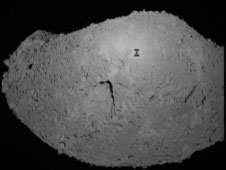June 30, 2010 Vol. 3, Issue 6
After a seven-year journey to an asteroid and back, JAXA’s Hayabusa returned home.
For Hayabusa, getting home was somewhat of an incredible journey. Hayabusa, which in Japanese means “peregrine falcon,” was the Japanese Aerospace Exploration Agency (JAXA) mission designed to collect material samples from the Itokawa asteroid.

Hayabusa’s shadow on the asteroid Itokawa shortly after it arrived in early September 2005. Credit: ISAS/JAXA
Launched on May 9, 2003, Hayabusa was originally intended to return from its mission in 2007. However, over the course of its journey the probe experienced problems with the solar arrays, ion engines, several batteries, and two of the three attitude-controlling reaction wheels, causing several delays and losses in communication. Still, JAXA found a way to travel the two billion kilometers to rendezvous with the asteroid in September of 2005, deploy its canisters to collect material samples from the surface, and start the journey home.
By November 2009, Hayabusa had achieved 90% of the course correction necessary to get back to Earth—except that it didn’t have enough thrust to make it all the way home. In the same month, its last fully functioning ion engine experienced an anomaly.
Hayabusa was equipped with four ion engines, each containing an ion source and a “neutralizer.” While two of the ion engines were dead, the other two were semi-functional: one had only a functioning ion source, and the other only had a functioning neutralizer. With fortuitously built-in cross-connections between the engines in the system (just in case something drastic happened), JAXA ground controllers were able to connect the working ion source of one engine to the working neutralizer of the other, creating a “virtual engine” that took Hayabusa the rest of the way home.
Between April and June of this year, Hayabusa performed a number of trajectory correction maneuvers to reenter the atmosphere on June 13 at approximately 10:00AM (EDT) and land in the Woomera Prohibited Area in South Australia. Armed with the samples from this mission, scientists hope to gain a better understanding of how asteroids formed.
Read more about JAXA’s Hayabusa spacecraft.






